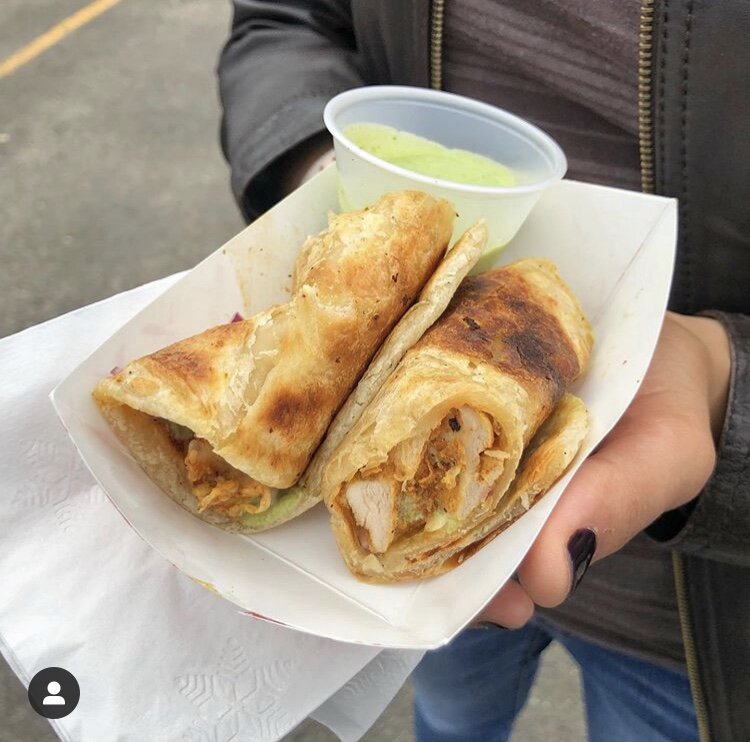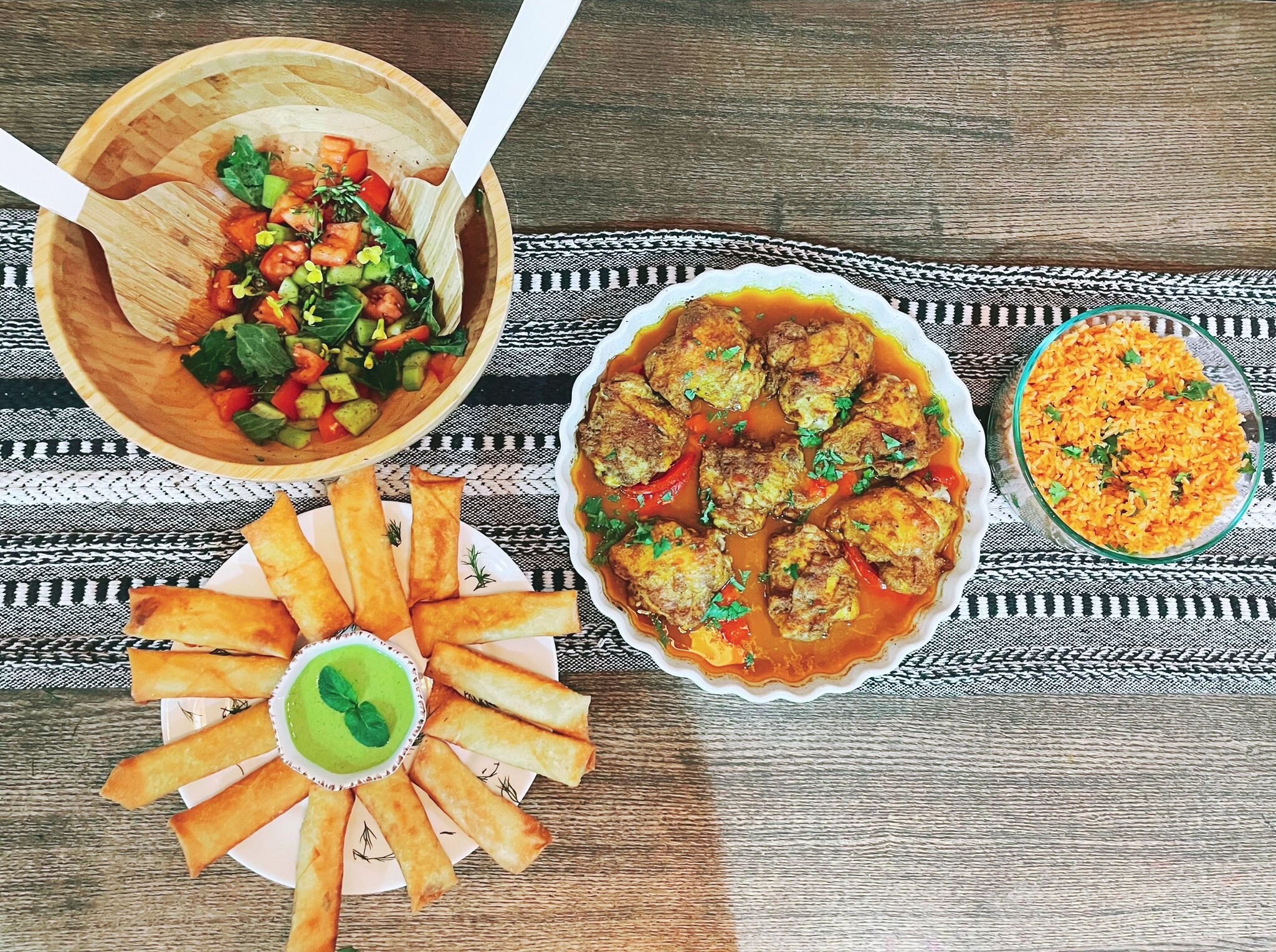Bajias with Dhanya Chutney (South Africa)

Shereen is a second generation South African. Her grandparents were originally from small rural villages in India and moved to South Africa to work in the coal mines under the British. Eventually they brought the whole family along and left the mines to open -as many others did- grocery stores in their townships.
Shereen grew up under Apartheid but was sheltered from it for many years. “Our parents never really talked about it as much. And it was just kind of a status quo. Like we just only live and work and interact with people from the same sort of background as you.” That said, Shereen did get to mingle with different people through her schooling. As civil unrests threatened public schools, her parents sent her and her siblings to a private Catholic missionary school, where classrooms were mixed race and her classmates came from different religious and cultural backgrounds.
Shereen’s maternal grandparents with their children
“It’s funny because I didn't really understand or really know apartheid until I was in [public] high school” she explains. Though it was at the tail end of apartheid, schools remained segregated. Conversations in class made her realize that the system under which she lived wasn’t normal. “It was an interesting time to be a teenager and get a greater awareness of who you are in that greater context. Because we’re not black, we’re not white, and I think being Indian or Malay in South Africa, it was a very different experience…we were kind of stuck in the middle”.
Shereen met her husband at university where she studied to be an occupational therapist. After they got married, she joined him in the United States where he had been recruited. Initially they lived in San Francisco, which felt similar to Cape Town in many ways, with its proximity to water and nature. Eventually they settled in Minnesota where they’ve remained and are raising their two daughters.
Though there aren’t many other South Africans where they live, Shereen and her husband have found her local “global” community. “We have a lot of friends who aren't necessarily Muslim but who are immigrants too. So we've started this new tradition on Eid, where we invite our friends over and I cook a big meal and we have a party with everyone and we get little gifts for the kids and and just hang out and eat and have a good time….It's a tradition that started because our friends who are Christians would invite us to Christmas parties and then Easter and all. I also have friends who are Orthodox, so whatever traditions they have they’re always including us. And so we do the same. And our kids, who are from different traditions can learn some of the rituals from all over”.
Shereen credits her experience in missionary school, which exposed her to people different from her, for her spirit of openness and her understanding of other religions and beliefs. “We were not expected to participate in the Catholic communion classes, but sitting in the back of the Chapel during that time, I did learn the Hail Mary’s and other things which I still remember today” she says with a laugh.
This year, as the pandemic forces everyone home, the communal aspect of Ramadan has taken a toll, though the holy month’s essence remains. “It's a moment to take a step back from the day-to-day and just a time to really connect with that spiritual side. Sometimes it's hard to do, being a mom, being on the go, working, all of that… it can be really hard to tap into that and Ramadan gives you a chance to slow down and really, really focus on that”, Shereen explains. “And for the kids, it's a moment for us to remember to be grateful for all those things that we have in our home and in our lives. And keeping you aware that that may not be the case for everyone, and how can we help and do something good?”
Though she has not been back to South Africa during Ramadan since her move to the US, Shereen has fond memories of family gatherings when she was little and her grandmother was still alive. “When we lived in Johannesburg, we had all these little traditions in preparation for the end of Ramadan. First, there are a lot of foods that we eat during Ramadan, but we don't eat any other time of the year. And so those were always a treat. And food is the one way that -at least for my my mom and her siblings- that was the one way they could express their culture. The other way was that we would always wear traditional clothing because my grandmothers are from India, they would always have some salwar kameez or something brand new. And then my grandmother would mix henna, and we'd always get to put henna on our hand for Eid. So we'd sit at the table with henna on our hands while my aunts and my mom and everybody was in the kitchen baking and cooking. So a lot of my memories of Eid are in a kitchen with the women of my family”.
In that spirit, Shereen is sharing her mom’s bajias recipe, with a dhunya chutney dip. And on the sweet side, you can find her recipe for a wonderfully refreshing falooda milkshake here.
“Bajias is something that everyone in South Africa of Indian or Malay heritage or anything like that, will have during Ramadan or any big celebration… The tradition for us in South Africa, is that we normally have savory items like snack foods that are fried or baked and laid out on the table. So you have something very savory and then you have something very sweet, and you have your date. And that's what at the time of Iftar, we'll break up fast with. Usually people will have these little snack foods and then they'll go and pray before coming back and eat their main meal…Here in Minnesota, people tend to just break their fast and eat their main meal straight away”.
Another tradition that Shereen has not had the opportunity to keep up with in the US is the exchanging of food. “You would make it ahead of time and then you'd always send your neighbor some plate of food made extra, and then your neighbor would send your plate back with something in it. So there was exchange of food right before sunset”.
This bajias recipe was passed down to Shereen’s mom from her own mom. “My grandmother never spoke any English, nor could read or write. So a lot of what she passed on to my mom was verbal. And so they made a lot of things without actually having a recipe. When I started to cook, I had to get my mom to write things down for me”.
Bajias
Ingredients for about 6-8 people
1 medium potato grated
3 scallions sliced
1 onion finely chopped
1 fresh green chili chopped
1 sprig mint leaves finely chopped
2 tbsp cilantro finely chopped
1 cup all-purpose flour
1 cup garbanzo bean flour
1 tbsp cornstarch
1.5 tsp baking powder
1 tsp salt
1.5 tsp coriander powder
1 tsp cumin powder
1/4 tsp turmeric
1/4 tsp chili powder
1/2 cup water
vegetable oil for frying
Directions
Place all ingredients in a bowl, mix well first and then add water slowly until a dough is formed. The dough must not be wet.
Heat the vegetable oil in a pot over medium heat.
Place tablespoon fulls of dough in the hot oil and fry it slowly until golden brown and crispy.
Drain on a paper towel and serve hot with dhanya chutney.
Dhanya chutney
Ingredients
1 bunch cilantro
3 sprigs of mint
4 cloves of garlic
1 tsp cumin seeds
salt to taste
1-2 green chilis (depending on how hot you would like it)
1/4 cup vinegar
1/4 cup vegetable oil.
Directions
Place all ingredients in a blender and blend until smooth.
Place in a jar and store in the fridge.
Serve this dipping sauce with the bajias.










